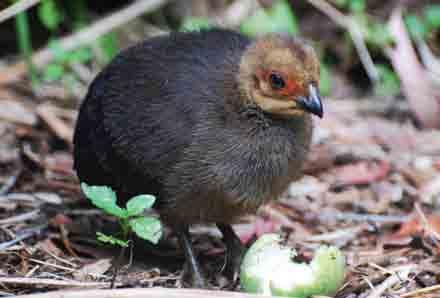
4 minute read
Stealth invaders An alien mussel slips in by Don Colgan
MOTHS TO A FLAME
Left
Scientists use simple light traps like this one to capture a diversity of insects. Photo by Dave Britton.
Right
Quail or Brush Turkey chick? Photo © Dr Paul Stewart.
Mention ‘pollution’ and you might think of poisoned water, rubbish-strewn streets or toxic brown fumes, but there are other types, including some we don’t often consider, like light pollution. Yet light pollution is quite a problem and has been growing for a number of years. Astronomers are already aware that bright lights from the towns and cities at night are so strong that detecting the comparatively faint light from distant celestial bodies can be difficult, even with powerful telescopes. As a result, modern observatories are usually built well away from suburban/ urban areas, often in remote inland sites. Clearly light pollution affects astronomers, but it must be pretty harmless to the rest of the natural world as it’s only light, right? Light can’t hurt you, can it? Well perhaps not humans, but many animals which migrate over long distances often use the distant light of the sun, moon and stars to keep them on track. They can do this because the faraway distant light is virtually perpendicular to the earth’s surface. Some scientists believe that the navigating animal keeps this distant light striking its eyes at the same angle so it can travel in a straight line. Unfortunately, animals will instinctively try to use bright artificial lights in the same way. These emit light rays at right angles to the source, with the effect that the light beams radiate out like the spokes on a bicycle wheel. To keep the light at a constant angle to their eyes, the migrating animals must continuously change course as they try to pass the lights, which results in the familiar spiral path that moths and beetles follow as they fly into a light bulb or candle flame. Whenever the unfortunate insect tries to leave, it automatically corrects its flight path and ends up at the light again. Like guests in the Hotel California, they can check out but never leave. When morning comes, their burnt, exhausted or dead bodies are easy pickings for the birds. Any survivors will hide away until nightfall, only to repeat the exercise and suffer the same fate.
Nor are these the only animals affected by light pollution. Larger animals, like fishes and cephalopods in the oceans, and birds, bats, frogs and nocturnal reptiles on land, have all been known to change their behaviours to feast on the smaller prey attracted to lights. A quick check of your garden will usually reveal a higher concentration of spider webs around the outdoor lights or windows for the same reason.
So is there a solution? Well, responsible homeowners, businesses and councils can simply replace white outdoor lighting with yellow-coloured bulbs, as it is the ultraviolet component of white light that seems to attract flying insects.
THE FEARLESS QUAIL
We often get enquiries to help people identify a strange bird they have seen in their garden but cannot seem to find in any of their Australian bird field guides. Sometimes the mystery bird is an escaped exotic cage bird; others can be unusual colour variations of a more common species (the all-black Galah is my pick of these). And sometimes it’s because the bird is a juvenile. Over summer, we’ve had many enquiries about ‘quails’, wandering about in suburbia and seemingly quite tame. A few hints about their true identity are already present in this brief description! The first is that the ‘quail’ is by itself; most quail travel in small flocks (called coveys). The second is that the bird seems tame, whereas most quail – even pet ones – are far from ‘tame’ and generally run or crouch when approached, or suddenly explode in a flurry of beating wings when disturbed. Hardly ‘tame’ behaviour. A quick question or two about the colour, and lack of a tail, and the true identity is revealed as the chick of a Brush Turkey, Alectura lathami.
‘Oh no’, they say. ‘It can’t be that! This one could fly and there were no parents nearby looking after it!’ Well one of the strange things about megapodes (the mound-building birds of Australasia like the Brush Turkey) is that the chicks hatch ready equipped with flight feathers ready to fly. Stranger still, despite months of moundbuilding and careful attention to the nest and its eggs, the parent birds don’t care for the hatchlings at all, which are on their own from day one; indeed the parents don’t even seem to recognise the chicks as their own species. Fortunately, the chicks are remarkably good at raising themselves and can find food and keep out of danger – which is why there are so many Brush Turkeys around Sydney’s northern suburbs in recent summers I’d guess. They also seem to keep an eye on one another and learn from each other’s successes and mistakes.

Certainly many of Australia’s megapode chicks (Australia has the Brush Turkey, Jungle Fowl and Mallee Fowl) fall prey to predators, but those that survive will fly straight up into the trees or dive deep into dense cover if alarmed.
So if the ‘quail’ looks like the image shown here and they’re walking about like they own the place – they ain’t quail!
MARTYN ROBINSON
IS THE MUSEUM’S RESIDENT NATURALIST








